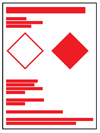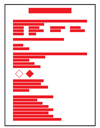Globally Harmonised System
The globally harmonised system for the classification and labelling of chemicals (GHS) is used internationally to standardise and harmonise the classification and labelling of chemicals.
In Queensland, hazardous chemical products (i.e. classified as a hazardous chemical under the Work Health and Safety legislation) that are being imported or manufactured must be labelled under the GHS unless a specific exemption applies. Regardless of any labelling exemptions, all hazardous chemical products must have a current safety data sheet that reflects GHS information.
The Work Health and Safety Regulation 2011 refers to the GHS labelling criteria in the schedules. This can be seen in:
- Schedule 6 – classification of mixtures
- Schedule 9 – classification, packaging and labelling requirements
- Schedule 11 – placarding and manifest
What you need to know overview
This information below provides you with an easy to understand summary of the GHS.

What is the GHS?
The Globally Harmonised System of Classification and Labelling of Chemicals (GHS) is an internationally agreed system for classifying and labelling hazardous chemicals.

Why do we need it?
The GHS will reduce time and costs, remove barriers to trade, and protect people and the environment from chemical hazards.

Who does it affect?
If you are a manufacturer, importer, seller or user of hazardous chemicals, you need to take action on changes to labelling and classification.

What are the changes?
The changes affect the way chemicals are classified and how information is communicated.

Pictograms
The GHS uses nine standard symbols with one of two word signal statements - danger or warning.

Labels
Changes to labels include simpler hazard and precautionary statements.

Safety Data Sheets
The Safety Data Sheets (SDS) uses clear language under 16 universal headings.

Other countries
Some of our largest trading partners have adopted the GHS, making trade easier between us.

In Australia
Australia began transitioning in 2012 after adopting the GHS Third Edition.
GHS pictograms and hazard classes
There are nine hazard pictograms in the GHS which represent the physical, health and environmental hazards.
Exploding bomb | Flame | Flame over circle |
|---|---|---|
Explosive |
Flammable |
Oxidising |
Gas cylinder | Skull and crossbones | Exclamation mark |
Gases under pressure |
Acute toxicity |
Health hazards |
Corrosion | Health hazard | Environment |
Corrosive |
Chronic Health hazard |
Environmental |
Transition to GHS 7
On 1 January 2021, Australia started a two-year transition to the 7th revised edition of the GHS (GHS 7).
During the transition, manufacturers and importers may use either GHS 3 or GHS 7 to prepare classifications, labels and SDS for hazardous chemicals.
From 1 January 2023, only GHS 7 may be used.
GHS 7 introduces several changes to classification, labelling and safety data sheet (SDS) requirements for workplace hazardous chemicals. The key changes between GHS 3 and GHS 7 are:
- new hazard categories and classes for:
- desensitised explosives
- pyrophoric gases
- chemically unstable gases
- non-flammable aerosols
- updated precautionary statements.
In addition to these changes, the definition of ‘hazardous chemical’ will be clarified to ensure it captures all Category 2 eye irritants. Chemicals can be further sub-categorised as Category 2A and 2B, but this is not mandatory in Australia.
Transitional arrangements
Classification and labelling in accordance with the GHS has been mandatory since 1 January 2017.
The introduction of the GHS relates to classification and subsequent safety data sheet and label references only. Form and dimensions for placards required for package stores and tanks remain unchanged. Refer to Schedule 13 of the Work Health and Safety Regulation 2011 for the placarding requirements (i.e. form and dimensions).
Amendments to the WHS Regulation commenced on 9 December 2016 which clarify that:
- a person conducting a business or undertaking (PCBU) who is an end user of a hazardous chemical can continue to use, store and handle non-GHS labelled hazardous chemicals manufactured or imported before 1 January 2017 and labelled in accordance with the NOHSC or the ADG Code
- duplicating information on a label is unnecessary where it is required by other labelling laws providing it does not decrease the level of protection or information in relation to the hazards of the chemical - refer to Appendix E precedence rules of label elements within the Labelling of workplace hazardous chemicals Code of Practice 2021 (PDF, 1.25 MB)
- veterinary chemicals listed in Schedule 4 and 8 of the Standard for the Uniform Scheduling of Medicines and Poisons are exempt from WHS labelling requirements when they are in a form intended for direct administration to animals for therapeutic purposes
- suppliers of hazardous chemicals can continue to supply non-GHS labelled hazardous chemicals manufactured or imported before 1 January 2017 provided the chemicals are labelled in accordance with the NOHSC or the ADG Code.
GHS classification
The GHS classification process uses defined criteria to identify the hazard(s) of a chemical or mixture by assigning a category of hazard/danger.
The GHS classes cover physical, health and environmental hazards. The GHS provides:
- definitions of health, physical and environmental hazards
- classification processes
- communication of hazard information and protective measures via labels and safety data sheets (SDS).
Physical hazards are largely based on the existing criteria used by the UN Recommendations on the Transport of Dangerous Goods, Model Regulations (UNRTDG). The ADG Code for the safe transport of dangerous goods by road and rail in Australia is based on it.
You can access a copy of the ADG Code from the National Transport Commission.
To help you to understand the GHS, the UN has published Understanding the Globally Harmonized System of Classification and Labelling of Chemicals (GHS) – A companion guide to the purple book .
Supporting codes of practice
The following supporting codes of practice for labelling and SDS are now based on the GHS:
- Labelling of workplace hazardous chemicals Code of Practice 2021 (PDF, 1.25 MB)
- Preparation of safety data sheets for hazardous chemicals Code of Practice 2021 (PDF, 1.03 MB)
More information
For more information on hazardous chemicals and the GHS, visit the Safe Work Australia website.
A comparison of the GHS hazard classes and categories and the equivalent Australian Dangerous Goods (ADG) code for placard and manifest quantities is provided in Hazardous chemicals – placard information and manifest quantities information (PDF, 0.2 MB).
Resources
GHS resources include:
Workplace Health and Safety Queensland
- Labelling of workplace hazardous chemicals Code of Practice 2021 (PDF, 1.25 MB)
- Preparation of safety data sheets for hazardous chemicals Code of Practice 2021 (PDF, 1.03 MB)
- Hazardous chemical: Are you ready for GHS7?








